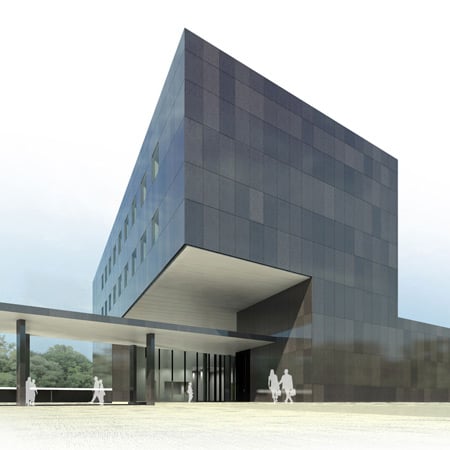Architects HOK have released images of their design for a new British Embassy building in Jakarta, Indonesia.
Public services will be on the ground floor, with embassy offices on the top two floors.
Rainwater falling on the structure will be collected and stored for irrigation and use within the building.
The project is due for completion in 2011.
The following information is from HOK:
--
HOK has released the first images of its dynamic design for the Foreign and Commonwealth Office’s new British Embassy building in Jakarta.
The 3,800 m² scheme is designed over three levels and is located on a 1.5 hectare site in central Jakarta. The project is due to complete in 2011.
The design, expressed in a spiralling form, folds around a central protected courtyard and twists up and outwards to form the Embassy’s public entrance invoking a sense of calm assurance. Sustainability is a key design consideration and challenge: Jakarta is in a highly seismic zone with excessive humidity levels; rain falls for eight months a year. Currently the design has been assessed as Excellent under the BREEAM rating. Site security has also influenced the scheme and is the logic to the centrally located building footprint.
The public and private functions within the building are separated with public services located on the ground floor and private Embassy functions located above. The public courtyard brings the tropical landscape into the heart of the building with a contained and controlled environment, very different in character to the lush landscape around the building.
Water recycling is important: all rain water falling on the structure will be collected, stored and used for irrigation and grey water purposes; this will also reduce the burden on the City’s water systems. To help eliminate solar gain, the Embassy is designed on an east-west axis.
HOK’s project director, Andrew Barraclough comments: “This is a fantastic project in a truly challenging climate. We’re giving considerable thought to the use of locally sourced materials to give an excellent life cycle. We want the building to appear as if it’s been hewn from a single piece of stone to provide a sense of solidity and security.”
The FCO’s project sponsor added: “HOK’s challenge is to balance the design to realise both security and accessibility. This is being achieved with considerable thought being given to the environment.”
HOK is collaborating with MACE the FCO’s Strategic Partner, Ramboll Whitby Bird as structural, facade and MEP engineers; and TPS as security advisors.

